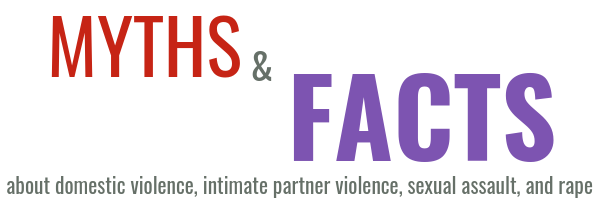There are many common myths and misconceptions surrounding domestic violence and sexual assault. These shape the way in which society perceives and responds to violence perpetrated against the victim or survivor. Such myths and attitudes are harmful as they tend to blame the survivors for the violence, rather than holding perpetrators responsible for their behavior.Together we can ensure those around us are provided with factual and accurate information which will aid in supporting survivors, holding abusers responsible, and providing a safer community for us all.
MYTH 1: Victims allow intimate partner violence to happen to them. If they really wanted to, they could leave their abusive partners.
FACT
The dynamics of violent relationships, such as the Stockholm Syndrome or the Power and Control Wheel, perpetrators use a combination of tactics of control and abuse that make it very difficult for victims to escape the violence. It is important to understand that those who experienced violence from an intimate partner and seek to leave the relationship in order to ensure their own and their children’s safety paradoxically face an increased risk of repeating and even escalating violence. Many are also prevented from leaving violent relationships due to feelings of shame and guilt, lack of safe housing, or the belief that divorce or separation is wrong for children.
MYTH 2: A lot of sexual assault victims lie about being raped or give false reports.
FACT
Only 2-8% of rapes are falsely reported.
MYTH 3: Domestic violence is rare and is no longer a significant problem.
FACT
Domestic violence is a HUGE problem. Domestic violence affects 1 out of 3 women at some point during her lifetime. Men can also be victims of domestic violence, and about 1 out of 4 have experienced some form of intimate partner violence. Domestic violence happens at higher rates for those in the LGBTQ community. The State of Tennessee has consistently ranked in the Top 5 for most murders of an intimate partner, and is the leading cause of female homicide and female injury.
MYTH 4: Domestic violence is always physical abuse.
FACT
While physical abuse can be one way of maintaining power and control, it does not occur in every abusive relationship and is usually not the only form of abuse if it is occurring. Emotional abuse, financial abuse, sexual abuse, isolation, threats, and intimidation are all forms of domestic violence.
MYTH 5: Victims provoke sexual assaults when they dress provocatively or act in a promiscuous manner.
FACT
Rape and sexual assault are crimes of violence and control that stem from a person’s determination to exercise power over another. Neither provocative dress nor promiscuous behavior are invitations for unwanted sexual activity. Forcing someone to engage in non-consensual sexual activity is sexual assault, regardless of the way that person dresses or acts.
MYTH 6: Most sexual assaults are committed by strangers. It’s not rape if the people involved knew each other.
FACT
Most sexual assaults and rapes are committed by someone the victim knows. Among victims aged 18 to 29, two-thirds had a prior relationship with the offender. Research has shown that in most reported cases, sexual assault victims stated the offender was an intimate partner, other relative, a friend or an acquaintance. For both completed and attempted rapes, about 9 in 10 offenders were known to the victim. In a study of college women, most often, a boyfriend, ex-boyfriend, classmate, friend, acquaintance, or co-worker sexually victimized the women. Sexual assault can be committed within any type of relationship, including in marriage, in dating relationships, or by friends, acquaintances or co-workers. Sexual assault can occur in heterosexual or same-gender relationships. It does not matter whether there is a current or past relationship between the victim and offender; unwanted sexual activity is still sexual assault and is a serious crime.
MYTH 7: Abuse only happens in certain “problem” families, ethnic minorities, uneducated or poorer areas.
FACT
Abuse pervades every ethnic, social strata. White collar workers are just as likely to abuse their wives as are blue-collar workers; financially independent people are just as likely to suffer abuse as are people on low incomes. It is not the social standing, the amount of stress lived under or the company kept which makes an abuser, but the internal need for power, the belief that they have the right to control someone else.
MYTH 8: Domestic violence is a family matter.
FACT
Abusing, battering, assaulting or raping another person is a criminal offence. Domestic violence has far-reaching social implications for everyone, affecting the victimized person’s ability to lead a productive life and encouraging children brought up in an abusive home to repeat the cycle themselves and having a detremental impact on their emotional and sometimes physical well-being. A lot of doctors and hospital time and funds are needed to help those who have been victimized or beaten.
MYTH 9: All real sexual assault victims will report the crime immediately to the police. If they do not report it or delay in reporting it, then they must have changed their minds after it happened or wanted revenge.
FACT
There are many reasons why a sexual assault victim may not report the assault to the police. It is not easy to talk about being sexually assaulted. The experience of re-telling what happened may cause the person to relive the trauma. Other reasons for not immediately reporting the assault or not reporting it at all include fear of retaliation by the offender, fear of not being believed, fear of being blamed for the assault, fear of being “revictimized” if the case goes through the criminal justice system, belief that the offender will not be held accountable, wanting to forget the assault ever happened, not recognizing that what happened was sexual assault, shame, and/or shock. In fact, reporting a sexual assault incident to the police is the exception and not the norm. From 1993 to 1999, about 70% of rape and sexual assault crimes were not reported to the police. Because a person did not immediately report an assault or chooses not to report it at all does not mean that the assault did not happen.
MYTH 10: Men, lesbians, and gay men don’t get battered or abused.
FACT
1 in 4 men will experience intimate partner violence in their lifetimes, and people in the LGBTQ community may actually experience higher than normal rates. Sexual orientation doesn’t make any difference. Abuse is about control within a relationship and can occur within any relationship where one partner believes they have the right to control the other.




